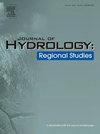Identification of dominant drivers of streamflow spatiotemporal variations in typical mountainous areas in the Hexi Corridor, China
IF 4.7
2区 地球科学
Q1 WATER RESOURCES
引用次数: 0
Abstract
Study region
Typical mountain areas in the Hexi Corridor, China.
Study focus
Water security and ecosystem sustainability of arid inland river basins are highly dependent on upstream streamflow. However, due to the complex geographical environment and limited observation data in the study region, the attribution of spatiotemporal variations in streamflow influenced by climate change and/or human activities remains unclear. Here, we used partial least squares regression (PLSR) and the Budyko framework to unravel the dominant drivers of spatiotemporal variation in streamflow over the past 30 yr.
New hydrological insight for the region
Precipitation, topographic wetness index, slope, forest land, gross primary productivity, hydrological connectivity, soil organic carbon content, silt content, relative relief, NDVI and gravel content dominated spatial variation in streamflow. Temporal variation of streamflow was sensitive to precipitation and land surface. Specifically, increased precipitation and land surface alteration dominated the increase in streamflow in 50 % of the watersheds and the decrease in streamflow in 33 % of them, respectively. Further, land surface alteration was dominated by expansion of agricultural and built-up areas, weakened hydrological connectivity, increased landscape aggregation and forest cover. Controlling agricultural and built-up areas and the scale of afforestation, and focusing on the dynamics of hydrological connectivity and landscape patterns in the upstream reaches are imperative to maintain the security and sustainability of water resources in the arid inland river basins.
确定中国河西走廊典型山区河水时空变化的主要驱动因素
研究区域中国河西走廊的典型山区。研究重点干旱内陆河流域的水安全和生态系统可持续性高度依赖于上游河水流量。然而,由于研究区域复杂的地理环境和有限的观测数据,受气候变化和/或人类活动影响的径流量时空变化的归因仍不明确。降水、地形湿润指数、坡度、林地、总初级生产力、水文连通性、土壤有机碳含量、粉砂含量、相对地形、NDVI 和砾石含量主导了溪流的空间变化。溪流的时间变化对降水和地表很敏感。具体而言,降水增加和地表改变分别主导了 50% 流域的溪流增加和 33% 流域的溪流减少。此外,农业区和建筑区的扩大、水文连通性的减弱、景观聚集度的增加和森林覆盖率的提高也是地表变化的主要原因。要保持干旱内陆河流域水资源的安全性和可持续性,就必须控制农业区和建筑区以及植树造林的规模,并关注上游水文连通性和景观格局的动态变化。
本文章由计算机程序翻译,如有差异,请以英文原文为准。
求助全文
约1分钟内获得全文
求助全文
来源期刊

Journal of Hydrology-Regional Studies
Earth and Planetary Sciences-Earth and Planetary Sciences (miscellaneous)
CiteScore
6.70
自引率
8.50%
发文量
284
审稿时长
60 days
期刊介绍:
Journal of Hydrology: Regional Studies publishes original research papers enhancing the science of hydrology and aiming at region-specific problems, past and future conditions, analysis, review and solutions. The journal particularly welcomes research papers that deliver new insights into region-specific hydrological processes and responses to changing conditions, as well as contributions that incorporate interdisciplinarity and translational science.
 求助内容:
求助内容: 应助结果提醒方式:
应助结果提醒方式:


